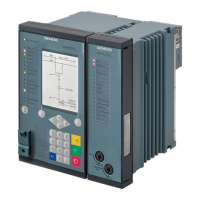[dw_kick-pulse_freq-adj-com, 1, en_US]
Figure 6-82 Kick Pulse and Frequency Adjustment Ranges
Stabilization and Supervision Actions
The parameter Smoothing causes a smoothing of the relevant measuring signal (dV and df) via a recursive
filter. The smoothing of the signals prevents wrong balancing commands from being issued to control the
voltage and frequency in case of a strong fluctuation of the signals. The smoothing has a low-pass behavior
corresponding to a delay element of the 1st order (for PT1 behavior, see also Figure 6-89).
When the voltage and the frequency are adjusted simultaneously, you must ensure that the admissible over-
excitation limit for the generator is not exceeded. The overexcitation is determined by monitoring the (V/
V
rated
)/(f/f
rated
) ratio and compared to the admissible threshold value (parameter (V/Vrated)/(f/frated)).
When the threshold value is exceeded, a voltage balancing command is issued. In this way, the generator
returns to the admissible operating range. The maximum admissible voltage threshold (V2
max
) for V2 is deter-
mined using the overexcitation parameter and the f2/f
rated
ratio.
A generator can only be synchronized with a system when there is a certain amount of slip. The frequency
difference is a measure for the slip within the functionality. A practically constant frequency difference is
assumed when determining the switching point. When adjusting the frequency, take care that no frequency
balancing commands are issued near a potential switching point. When the frequency is in the admissible
band (parameters Max. frequency diff. f2>f1 and Max. frequency diff. f2<f1; see also
Figure 6-82), the currently determined angle difference of the voltage (dα) is used to calculate the speed of
change (dα/dt). This can be used to calculate the remaining time up to the synchronized point (dα → 0)
continuously. If the determined time reaches of the value for the parameter T close without balancing
or falls below it, a frequency balancing command will no longer be issued and any active frequency adjust-
ment will be discontinued.
Application and Setting Notes
Use the Synchronous/asynchronous stage type with balancing commands (Syn./Asy.bal.) for synchro-
nizing generators automatically.
You can find the Syn./Asy.bal. stage in the DIGSI 5 library under FG Circuit Breaker → Synchronization →
Function extensions.
6.4.9.2
Control Functions
6.4 Synchronization Function
SIPROTEC 5, High-Voltage Bay Controller, Manual 395
C53000-G5040-C015-9, Edition 11.2017

